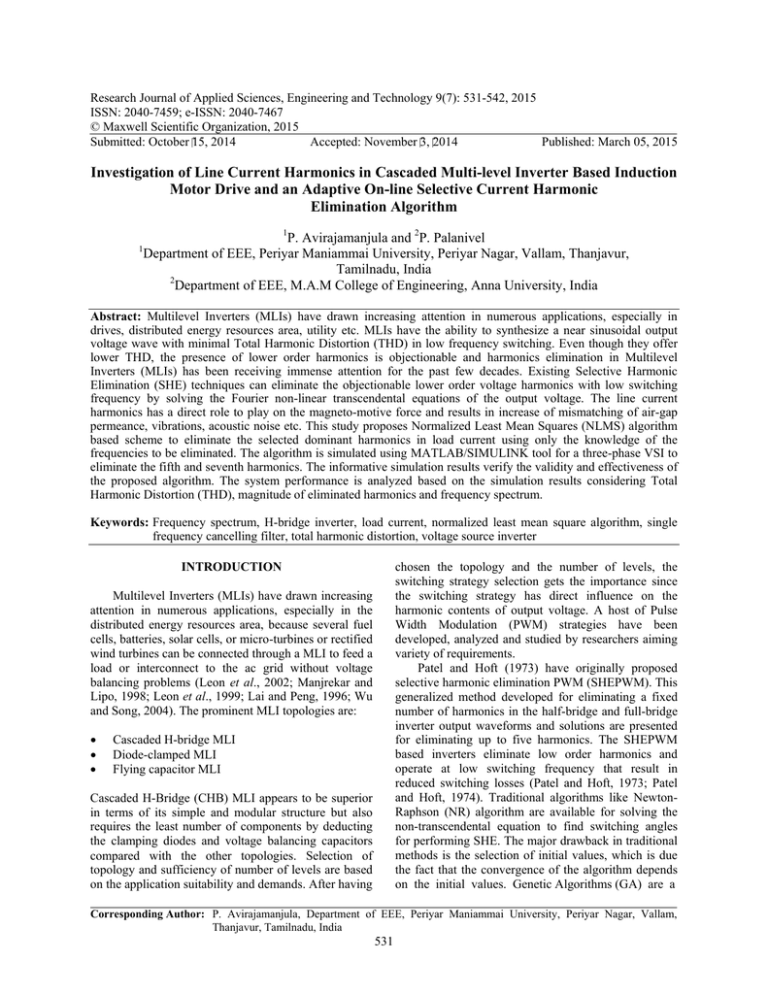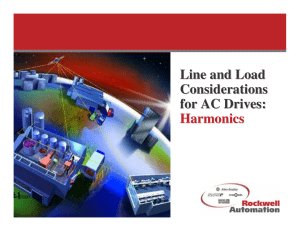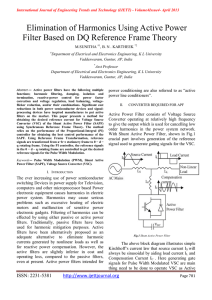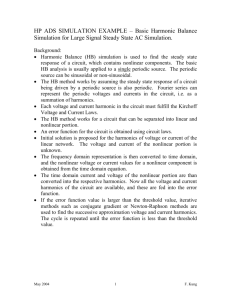Research Journal of Applied Sciences, Engineering and Technology 9(7): 531-542,... ISSN: 2040-7459; e-ISSN: 2040-7467
advertisement

Research Journal of Applied Sciences, Engineering and Technology 9(7): 531-542, 2015 ISSN: 2040-7459; e-ISSN: 2040-7467 © Maxwell Scientific Organization, 2015 Submitted: October 15, 2014 Accepted: November 3, 2014 Published: March 05, 2015 Investigation of Line Current Harmonics in Cascaded Multi-level Inverter Based Induction Motor Drive and an Adaptive On-line Selective Current Harmonic Elimination Algorithm 1 P. Avirajamanjula and 2P. Palanivel Department of EEE, Periyar Maniammai University, Periyar Nagar, Vallam, Thanjavur, Tamilnadu, India 2 Department of EEE, M.A.M College of Engineering, Anna University, India 1 Abstract: Multilevel Inverters (MLIs) have drawn increasing attention in numerous applications, especially in drives, distributed energy resources area, utility etc. MLIs have the ability to synthesize a near sinusoidal output voltage wave with minimal Total Harmonic Distortion (THD) in low frequency switching. Even though they offer lower THD, the presence of lower order harmonics is objectionable and harmonics elimination in Multilevel Inverters (MLIs) has been receiving immense attention for the past few decades. Existing Selective Harmonic Elimination (SHE) techniques can eliminate the objectionable lower order voltage harmonics with low switching frequency by solving the Fourier non-linear transcendental equations of the output voltage. The line current harmonics has a direct role to play on the magneto-motive force and results in increase of mismatching of air-gap permeance, vibrations, acoustic noise etc. This study proposes Normalized Least Mean Squares (NLMS) algorithm based scheme to eliminate the selected dominant harmonics in load current using only the knowledge of the frequencies to be eliminated. The algorithm is simulated using MATLAB/SIMULINK tool for a three-phase VSI to eliminate the fifth and seventh harmonics. The informative simulation results verify the validity and effectiveness of the proposed algorithm. The system performance is analyzed based on the simulation results considering Total Harmonic Distortion (THD), magnitude of eliminated harmonics and frequency spectrum. Keywords: Frequency spectrum, H-bridge inverter, load current, normalized least mean square algorithm, single frequency cancelling filter, total harmonic distortion, voltage source inverter chosen the topology and the number of levels, the switching strategy selection gets the importance since the switching strategy has direct influence on the harmonic contents of output voltage. A host of Pulse Width Modulation (PWM) strategies have been developed, analyzed and studied by researchers aiming variety of requirements. Patel and Hoft (1973) have originally proposed selective harmonic elimination PWM (SHEPWM). This generalized method developed for eliminating a fixed number of harmonics in the half-bridge and full-bridge inverter output waveforms and solutions are presented for eliminating up to five harmonics. The SHEPWM based inverters eliminate low order harmonics and operate at low switching frequency that result in reduced switching losses (Patel and Hoft, 1973; Patel and Hoft, 1974). Traditional algorithms like NewtonRaphson (NR) algorithm are available for solving the non-transcendental equation to find switching angles for performing SHE. The major drawback in traditional methods is the selection of initial values, which is due the fact that the convergence of the algorithm depends on the initial values. Genetic Algorithms (GA) are a INTRODUCTION Multilevel Inverters (MLIs) have drawn increasing attention in numerous applications, especially in the distributed energy resources area, because several fuel cells, batteries, solar cells, or micro-turbines or rectified wind turbines can be connected through a MLI to feed a load or interconnect to the ac grid without voltage balancing problems (Leon et al., 2002; Manjrekar and Lipo, 1998; Leon et al., 1999; Lai and Peng, 1996; Wu and Song, 2004). The prominent MLI topologies are: • • • Cascaded H-bridge MLI Diode-clamped MLI Flying capacitor MLI Cascaded H-Bridge (CHB) MLI appears to be superior in terms of its simple and modular structure but also requires the least number of components by deducting the clamping diodes and voltage balancing capacitors compared with the other topologies. Selection of topology and sufficiency of number of levels are based on the application suitability and demands. After having Corresponding Author: P. Avirajamanjula, Department of EEE, Periyar Maniammai University, Periyar Nagar, Vallam, Thanjavur, Tamilnadu, India 531 Res. J. App. Sci. Eng. Technol., 9(7): 531-542, 2015 family of soft computational models inspired by biological evolution. These algorithms encode a potential solution to a specific problem on a simple chromosome-like data structure and apply recombination operators to these structures as to preserve critical information. Genetic algorithms are often viewed as function optimizer, although the arrays of problem to which genetic algorithms have been applied are quite broad. An implementation of GA begins with a population of (typically random) chromosomes. Then it evaluates these structures and allocated reproductive opportunities in such a way that these chromosomes which represent a better solution to the target problem are given more chances to `reproduce' than those chromosomes which are poorer solutions. The 'goodness' of a solution is typically defined with respect to the current population. An adaptive filtering (Least Mean Squares (LMS) based) algorithm for the selective current harmonic elimination in a three phase ac voltage controller has been proposed by Padmanabhan et al. (2012). From the detailed literature survey, it is understood that major efforts has been put in voltage harmonic elimination. The researchers have started focus on the selective current harmonic elimination. The main objective of this paper is to develop an on-line adaptive algorithm for eliminating the objectionable line current harmonics present in a MLI fed induction motor drives. The developed Normalized Least Mean Squares (NLMS) algorithm based scheme eliminates the selected dominant harmonics in load current without any additional information other than order/frequency. The algorithm is implemented and tested in MATLABSIMULINK platform. It offers about 80, 60 and 34% reductions respectively, in 5th harmonics, 7th harmonics and THD. Fig. 1: Seven-level cascaded multilevel inverter harmonic content without transformers and filter circuits and at the lower switching frequency. The cascaded MLI consists of series of H-bridge (single-phase full-bridge) inverter units. As previously mentioned, the general function of this MLI is to synthesize a desired voltage from several SDCs, which may be obtained from batteries, fuel cells, solar cells and ultra-capacitors. Minimum harmonic distortion can be obtained by controlling the conducting angles at different inverter level (Gobinath et al., 2013). The seven-level cascaded inverter is shown in Fig. 1. Each SDCs is connected to a single-phase full-bridge inverter. Each inverter level can generate three different voltage levels, viz. +V dc , 0 and -V dc by connecting the dc source to the ac output side by different combinations of the switches. The ac output of each level’s full-bridge inverter is connected in series such that the synthesized voltage waveform is the sum of all of the individual inverter outputs (Fig. 2). METHODOLOGY Cascaded MLI: MLI was proposed by Nabae. A. Since then multilevel inverters have drawn much interest in the electrical power industry in recent years. They offer a set of features that are well suited for high-voltage drive systems and power system applications such as High Voltage DC (HVDC) transmission, reactive power compensating devices, power conditioning, active power filtering and so on. They were initially proposed as an extension of the conventional inverters to withstand increased DC link voltage produced by series connection of the semiconductor devices and effective clamping of voltage across each semiconductor in phase leg, through diodes (Neutral Point Clamped inverter) or capacitors. On the basis of which multilevel inverters have been classified as Diode clamped inverter, Capacitor Clamped inverter, Cascaded MLI and Hybrid type inverter. The unique structure of multilevel Voltage Source Inverters (VSIs) allows them to operate at high voltages with low Proposed ASHE algorithm: As shown in the below Fig. 3 the inverter had PI controller U_reg for dc bus voltage control and two PI regulators Iq 1 and Id 1 implemented in synchronous reference frame for current control. Reference angle for generation of sine and cosine functions with frequency of fundamental component and frequencies of fifth and seventh harmonics is created by a Phase Looked Loop (PLL) block. Sine and cosine components with fundamental frequency are phase locked with utility voltage and are used for stationary to synchronous (and vice versa) reference frames transformations. Sine and cosine components with five and seven times higher frequencies are used for selective harmonic elimination. Sample currents I a , I b , I c from the stationary (a, b, c) reference were transformed into two phase q, d stationary reference frame (block 3/2) and then into synchronous frame I q , I d (block s/e) (Sangeetha et al., 2010; Padmanabhan et al., 2011). 532 Res. J. App. Sci. Eng. Technol., 9(7): 531-542, 2015 Fig. 2: Seven-level inverter output voltage waveform generation Fig. 3: Proposed NLMS based ASHE scheme for MLI drive The conventional part of control works as follows: voltage regulator U_reg depending on dc bus voltage error creates an active current reference Iq*. For unity power factor reactive current reference I d * is kept zero. PI current regulators maintain an average value of feedback currents I q e and I d e equal to the average values of corresponding references. Outputs of current regulators are transformed first from synchronous to stationary reference frame (block e/s) and then from two-phase (q, d) to three phase (a, b, c) system and written into PWM control the inverter (Tomasini et al., 2009). The components contributed to PWM from ASHE blocks will create voltage at the output of the inverter with amplitudes and phase angles as needed to cancel harmonic components from the load currents (Qian et al., 2006). Least-squares algorithms aim at the minimization of the sum of the squares of the difference between the desired signal and the model filter output. When new samples of the incoming signals are received (at any iteration), the solution for the least-squares problem can be computed through continuous weight update. The NLMS algorithm is known to pursue fast convergence even when the Eigen value spread of the input signal correlation matrix is large. The algorithm is numerically robust, fast and parallelizable and has particularly good 533 Res. J. App. Sci. Eng. Technol., 9(7): 531-542, 2015 tracking properties. This algorithm has excellent performance when working in time-varying environment. All these advantages come with cost of an increased computational complexity and some stability problems (Mathews, 1991). In the standard form of a Least Mean Square (LMS) filter, the adjustment applied to the tap-weight vector of the filter at iteration (n+1) consist of the product of three terms: • • • of the filter. The normalized LMS filter is a manifestation of the principle of minimal disturbance, which may be stated as follows. From one iteration to the next, the weight vector of an adaptive filters should be changed in a minimal manner, subject to a constraints imposed on the updated filter’s output. To cast this principle in mathematical terms, let ŵ(n) denote the old weight vector of the filter at iteration n and ŵ(n+1) denotes its updated weight vector at iteration n+1. The criterion for designing the NLMS filter as that of constrained optimization now is formulated. Given the tap-input vector u(n) and desired response d(n), determine the updated tap-weight vector ŵ(n+1) so as to minimize the squared Euclidian norm of the change: The step-size parameter µ, which is under the designer’s control. The tap-input vector u (n), which is supplied by a source of information. The estimation error e (n) for real-valued data, or its complex conjugate e*(n) for complex-valued data, which is calculated at iteration n. ∧ ∧ ∧ δ w(n + 1) = w(n + 1) − w(n) The filter, shown in the following Fig. 4 consists of a combiner, a Least Mean Square (LMS) algorithm and a summing point. The adjustment is directly proportional to the tapinput vector u(n) and the adjustment applied to the tapinput vector u(n) at iteration n, hence the term “normalized”. In structural terms, the normalized LMS filter is exactly the same as the standard LMS filter. Both adaptive filter are built around a transversal filter, but only in the way in which the weight controller is mechanized. The M-by-1 tap vector u(n) produces an output y(n) that is subtracted from the desired response d(n) to produce the estimation error, or error signal, e(n). In response to the combined action of the input vector u(n) and error signal e(n), the weight controller applies a weight adjustment to the transversal filter. This sequence of events is repeated for a number of iterations until the filter reaches a steady state (Muneyasu et al., 2000). The normalized LMS filter may be formulated as a natural modification of the ordinary LMS filter. Alternatively, the normalized LMS filter may be derived on its own right; the latter procedure is considered here, as it provides insight into the operation (1) Subjected to constraint: ∧ H W (n + 1)u (n) = d (n) (2) To find the optimum value of the updated weight vector that minimize the cost function J(n), the following steps may be proceeded: • Differentiate the cost function J(n) with respect to ŵ(n+1). Then following the rule for differentiating a real-valued function with respect to a complexvalued weight vector: ∂J (n) ∧ ∧ ∧ = 2( w(n + 1) − w(n)) − λ * u (n) ∂ w* (n + 1) (3) Setting this result equal to zero and solving for the optimum value ŵ(n+1) results in: ∧ ∧ 1 W (n + 1) = w(n) + λ * u (n) 2 Fig. 4: Structure of single frequency cancelling filter 534 (4) Res. J. App. Sci. Eng. Technol., 9(7): 531-542, 2015 • Solve for the unknown multiplier λ by substituting the result of step 1 (i.e., the weight vector (n+1)) into the constraint. Doing the substitution, we first write 1: ∧ (5) • Then, solving for λ, will give: λ= • 2𝑒𝑒(𝑛𝑛) • (6) 𝑈𝑈(𝑛𝑛)^2 ∧ optimal value of the incremental change, δ w(n + 1) : • ∧ ∧ ∆ w(n + 1) = w(n + 1) − w(n) = 1 u ( n )e * ( n ) U ( n) ∧ 2 (7) ∧ ∧ ∧ u ( n )e * ( n ) (9) µ 𝑈𝑈(𝑛𝑛)^2 It is viewed that NLMS is a LMS with a time varying step-size parameter. Most importantly, the NLMS algorithm exhibits a rate of convergence that is potentially faster than that of the standard LMS algorithm for the both uncorrelated and correlated input data. RESULTS AND DISCUSSION In order to exercise control over the change in the tap-weight vector from one iteration to the next without changing the direction of the vector, a positive real scaling factor denoted by µ is introduced. That is: δ w(n + 1) = w(n + 1) − w(n) = U ( n) ∧ 2 The adaptation constant µ for NLMS is dimensionless, whereas the adaptation constant µ for the LMS has dimension of inverse power. Setting: µ(n) = where, e(n) = d(n) -ŵH(n)u(n) is the error signal. Combine the result of step 1 and 2 to formulate the ∧ µ Indeed, this is the desired recursion for computing the M-by-1 tap-weight vector in the normalized LMS algorithm. Equation clearly shows the reason for using the term normalized. The product vector u(n)e*(n) is normalized with respect to the squared Euclidian norm of the tap-input vector u(n). Comparing the recursion for the NLMS with that of the LMS, the following observations are made: ∧ d (n) = w(n + 1)u (n) ∧ 1 = ( w(n) + λ * u (n)) H u (n) 2 ∧ 1 H = w (n)u (n) + λu H (n)u (n) 2 ∧ w(n + 1) = w(n) + 1 u ( n )e * ( n ) U ( n) ∧ 2 The three phase seven level cascaded multilevel voltage source inverter is simulated with uncompensated dead time without and with ASHE algorithms. The operation of three-phase inverter is simulated with the proposed ASHE algorithm using MATLAB 7.0 (R2010a). The NLMS based ASHE algorithm is designed to eliminate 5th and 7th harmonic components of load current. The harmonic spectrum of line current after application of ASHE is shown in Fig. 5. Resulting waveforms at various stages of the scheme (Fig. 3) are illustrated from Fig. 6 to 17. (8) Equivalently, it can be written as: Fig. 5: Harmonic spectrum of line current with ASHE filter 535 Res. J. App. Sci. Eng. Technol., 9(7): 531-542, 2015 Fig. 6: Output at stage 1 (output current waveforms) Fig. 7: Output at stage 2 (abc to dq-stationary transformation) 536 Res. J. App. Sci. Eng. Technol., 9(7): 531-542, 2015 Fig. 8: Output at stage 3 (dq-stationary to dq-rotationary transformation) Fig. 9: Output at stage 4 (weights of NLMS in fundamental) 537 Res. J. App. Sci. Eng. Technol., 9(7): 531-542, 2015 Fig. 10: Output at stage 5 (weights of NLMS in 5th harmonic) Fig. 11: Output at stage 6 (weights of NLMS in 7th harmonic) 538 Res. J. App. Sci. Eng. Technol., 9(7): 531-542, 2015 Fig. 12: Output at stage 7 (output of MF SHE block) Fig. 13: Output at stage 8 (after correcting for capacitor fluctuation) 539 Res. J. App. Sci. Eng. Technol., 9(7): 531-542, 2015 Fig. 14: Output at stage 9 (dq-rotationary to dq-stationary transformation) Fig. 15: Output at stage 10 (reference vectors in two phase) 540 Res. J. App. Sci. Eng. Technol., 9(7): 531-542, 2015 Fig. 16: Output at stage 11 (dq stationary to abc transformation) Fig. 17: Output at stage 12 (gate pulses) 541 Res. J. App. Sci. Eng. Technol., 9(7): 531-542, 2015 Table 1: Comparison of different harmonic currents without and with ASHE filter Open loop (% of NLMS Component of current fundamental) (% of fundamental) Fundamental, I 1 100 100 5th harmonic, I 5 16.21 3.17 7th harmonic, I 7 7.85 3.19 THD (%) 26.27 17.43 Muneyasu, M., T. Harrada, Y. Yano and T. Hinamoto, 2000. A pipeline implementation of quadratic adaptive voltera filters based on LMS algorithm. Proceeding of SPAT2000, pp: 11-16. Padmanabhan, T.S., M. Sudhakaran and S. Jeevananthan, 2011. Selective current harmonic elimination in an AC voltage controller drive system using LMS algorithm. Proceeding of 46th International Universities’ Power Engineering Conference (UPEC, 2011), Paper-169, South Westphalia University of Applied Sciences, Soest, Germany, September 5th-8th. Padmanabhan, T.S., M. Sudhakaran and S. Jeevananthan, 2012. Novel adaptive control scheme for suppressing input current harmonics in three-phase AC choppers. Int. Rev. Automat. Control (I.RE.A.CO), 5(6): 783-789. Patel, H.S. and R.G. Hoft, 1973. Generalized harmonic elimination and voltage control in thyristor converters: Part I-harmonic elimination. IEEE T. Ind. Appl., 9: 310-317. Patel, H.S. and R.G. Hoft, 1974. Generalized harmonic elimination and voltage control in thyristor converters: Part II-voltage control technique. IEEE T. Ind. Appl., 10: 666-673. Qian, L., D. Cartes and Q. Zhang, 2006. Three-phase harmonic selective active filter using multiple adaptive feed forward cancellation method. Proceeding of IEEE International Power Electronics and Motion Control Conference (IPEMC, 2006), 2: 1-5. Sangeetha, S., C.H. Venkatesh and S. Jeevananthan, 2010. Selective current harmonic elimination in a current controlled DC-AC inverter drive system using LMS algorithm. Proceeding of International Conference on Computer Application in Electrical Engineering Recent Advances (CERA, 2009). Paper No. 333, Indian Institute of Technology, ROORKEE, Feb. 19th to 21st, 2010. Tomasini, M., R. Feldman, P. Wheeler et al., 2009. dpControl of high -power current source rectifiers utilizing selective harmonics elimination. Proceeding of IEEE Conference on Power Electronics and Applications (EPF '09). 13th pp: 111, Sep 2009. Wu, B. and P.G. Song, 2004. Comprehensive analysis of multi-megawatt variable frequency drives. T. China Electro-Tech. Soc., 19(8): 40-52. Table 1 compares the important results such as magnitudes of 5th and 7th harmonics and THD for with and without filtering. It offers about 80, 60 and 34% respectively reductions in 5th harmonics, 7th harmonics and THD. CONCLUSION One of the biggest problems in power quality aspects is the harmonic contents in the electrical drives. Harmonics will increase losses in drives and there will also be additional core losses due to harmonic frequency eddy currents. Eliminating harmonic content will make it easier to filter the remaining harmonic content. As a result, filters will be smaller and cheaper. The developed algorithm eliminates the selected dominant harmonics on-line. Besides reducing the harmonics it also minimizes the THD. REFERENCES Gobinath, K., S. Mahendran and I. Gnanmbal, 2013. Novel cascaded H-bridge multilevel inverter with harmonics elimination. Proceeding of IEEE International Conference on Green High Performance Computing (ICGHPC, 2013), pp: 1-7. Lai, J.S. and F.Z. Peng, 1996. Multilevel converters-A new breed of power converters. IEEE T. Ind. Appl., 32: 509-517. Leon, M.T., F.Z. Peng and T.G. Habetler, 1999. Multilevel converters for large electric drives. IEEE T. Ind. Appl., 35(1): 36-44. Leon, M.T., F.Z. Peng, T. Cunnyngham and J.N. Chiasson, 2002. Charge balance control schemes for multilevel converter in hybrid electric vehicles. IEEE T. Ind. Electron., 49(5): 1058-1065. Manjrekar, M. and T. Lipo, 1998. A hybrid multilevel inverter topology for drive applications. Proceeding of the Applied Power Electronic Conference. Anaheim CA, pp: 523-529. Mathews, V.J., 1991. Adaptive polynomial filters. IEEE Signal Proc. Mag., 8(3): 10-26. 542







